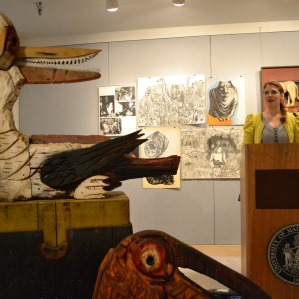The University of Maine at Presque Isle has become the premiere research facility for art lovers and scholars who want to study the artistic process of acclaimed sculptor Bernard Langlais after receiving a gift of more than 800 Langlais art pieces from the Kohler Foundation, Inc. UMPI officials announced the major gift and the establishment of the Langlais Study Collection during a press conference held on April 24 in the Reed Fine Art Gallery.
The press event provided the public with its very first glimpse of the new collection, which includes sketches, sketchbooks, studies, models, archives, and more than 30 wooden sculptures and wall pieces valued at more than $200,000. Many of the works are on display in the Reed Gallery for the exhibit Bernard Langlais: The Man Behind the Owls, which opens on May 2 during Presque Isle’s First Friday Art Walk and runs through June 21.
“We are thrilled beyond words to receive such a generous gift and to be able to serve as a champion of Langlais’ art for generations to come,” UMPI President Linda Schott said. “We are indebted to the Kohler Foundation for giving us so many works by a sculptor who holds such significance for our campus. We look forward to helping to preserve this piece of Langlais’ artistic legacy and welcoming visitors to campus who want to explore our learning collection.”
Bernard “Blackie” Langlais (1921-1977) has been a familiar name to the UMPI campus since the 1970s, when he created the 4-ton, 30-foot-tall outdoor wooden sculpture The Owls. Born in Old Town, Langlais was an internationally renowned artist, who received many of the art world’s top honors, including a Fulbright grant, Guggenheim fellowship, and Ford Foundation prize, and whose work has been featured in museums throughout the country, including the Whitney Museum, the Museum of Modern Art and the Art Institute of Chicago. “Blackie,” as he was affectionately called, was quite prolific in his artistic career—particularly in the last 10 years of his life—creating many works at his farm and studios in Cushing. He became known as an “animalier” with works that included large figurative outdoor wooden sculptures.
His Owls piece for UMPI was the result of a competitive commission contest initiated in 1976, and became his last sculpture. After more than three decades of harsh Aroostook County winters resulting in serious deterioration, the iconic sculpture underwent a restoration and preservation process—through the help of UMPI’s Physical Plant and Andres Verzosa, director and owner of Aucocisco Galleries in Portland, who has worked for years to preserve Langlais’ art. The Owls was relocated to the center of campus in 2012. Prior to the gift from the Kohler Foundation, it was the only Langlais work in UMPI’s entire art collection.
“Because the University has Langlais’ final artwork, it uniquely positioned the campus in the rich and prolific legacy of the renowned sculptor,” Heather Sincavage, Reed Gallery Director and curator of the new collection, said. “Acquiring the collection provides context that supports the importance of our Owls.”
To honor the recent Owls restoration, Sincavage had planned to assemble and curate an exhibition of Langlais’ work by borrowing artwork from existing collections. Through this process, however, Sincavage was referred to the Wisconsin-based Kohler Foundation. The Colby College Museum of Art had been willed the Langlais estate and, in 2012, gifted nearly 3,000 pieces of it to the Kohler Foundation to preserve and ultimately gift the works to non-profit institutions throughout Maine and the U.S.
The Kohler Foundation invited Sincavage to the Langlais estate in Cushing in the summer of 2013 to select a few items for her exhibition. Through the foundation’s generosity, Sincavage came away with a much more substantial amount of art work, including a carved wooden lion face thought to be Langlais’ self-portrait, five assemblage pieces, two scale models of The Owls, and a larger-than-life-sized Gerald Ford in an actual cast iron bathtub. The works on paper the University received, which includes Langlais’ sketchbooks, early paintings, chainsaw drawings, and accomplished pen and ink animal filled landscapes, comprise the Langlais Study Collection. A very special piece within this collection is a preliminary sketch on loose-leaf paper of The Owls.
Because the University is providing a permanent home for these hundreds of works, it will become a part of the official Langlais Art Trail. Currently in development, this art trail will provide art enthusiasts, Langlais fans, and anyone else interested with a “road map” connecting the locations in Maine and beyond where they will be able to view the works Langlais created throughout his prolific artistic career.
“It was truly a pleasure to work with the Kohler Foundation on this project,” Sincavage said. “Never in my wildest dreams did I think I would walk away with such a substantial gift. What I find even more special is that through Langlais’ legacy, we are part of a united collective of arts organizations across the state. I can’t think of a better way to connect with others across Maine!”
Anyone interested in viewing works from UMPI’s new Langlais Collection is invited to visit the Reed Gallery starting on May 2 whenBernard Langlais: The Man Behind the Owls officially opens. The public is invited to view the exhibit throughout the show’s run and attend the Opening Reception on May 2 from 5-7 p.m., which is being held in conjunction with the Presque Isle First Friday Art Walk. Sincavage will hold a Gallery Talk at 5:30 p.m. Light refreshments will be served. The exhibition will also be open for the First Friday Art Walk on June 6 from 5-7 p.m.
The Reed Fine Art Gallery is open Monday through Saturday 9 a.m. to 4 p.m. The gallery is closed Sundays and University holidays. For more information about this exhibition or UMPI’s Langlais Collection, please contact Sincavage at 768-9442 orheather.sincavage@maine.edu.

